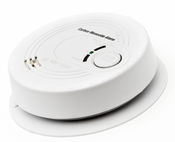Carbon monoxide

Carbon monoxide is a poisonous gas. It has no smell or taste meaning you could be inhaling it without realising it.
It you have an open fire, fuel burning stove or gas appliances in your home fit carbon monoxide alarm. Always have your appliances installed and regularly serviced professionals.
Fit a carbon monoxide alarm
- This will detect a leak in your home and give out a high-pitched noise when gas levels are high.
- They are reliable, easy to use, and inexpensive.
- Audible alarms are designed and tested for use in homes, but most are also portable and suitable for use on holiday, in caravans, boats or holiday homes.
- Remember to test your carbon monoxide alarm regularly to make sure it is working.
When buying an alarm
- Buy reputable branded alarms from reputable DIY and high street stores, plumbing stores, energy retailers, and gas engineers.
- Make sure a CE marking and proof of the EN50291 standard both appear on the packaging and the product. These markings guarantee that the product has been tested and certified to the EN50291 European standard.
- Avoid buying the cheapest alarms from unknown sellers.
- We do no recommend non-audible alarms as these require constant visual monitoring and will not make any noise to alert or wake you in case of an emergency.
The symptoms
- Recognise the symptoms of carbon monoxide poisoning.
- If you have the symptoms of carbon monoxide poisoning visit your GP or the hospital immediately.
If your carbon monoxide alarm sounds
- Keep calm, open doors and windows to ventilate the property.
- Stop using all fuel burning appliances and if possible turn them off.
- Evacuate the property leaving the doors and windows open.
- Ring your gas or other fuel supplier on their emergency number. Keep the number in a prominent place.
- Get medical help for anyone suffering the effects of carbon monoxide poisoning.
- Don’t re-enter the property until the alarm has stopped.
- Don’t use the appliance until it has been checked by an expert. If it is a gas appliance make sure the engineer is Gas Safe registered.
Preventing carbon monoxide poisoning
It is important to identify any appliances that could potentially leak carbon monoxide in your home.
Common item are that could leak
- oil and gas boilers
- portable generators
- oil or solid fuel cookers
- gas or paraffin heaters
- wood or gas fireplaces
- gas appliances
- any fossil fuel burning appliance
- clogged chimneys.
Installing maintaining and using appliances
- Make sure appliances are installed by professionals. For gas appliances, the engineers should be Gas Safe Registered.
- Have your appliances regularly serviced by a qualified service engineer.
- Regularly make visual inspections of all your fuel-burning appliances.
- Never ignore a safety device when it shuts off an appliance.
- Do not use a gas cooker to heat a room.
- Have your chimney swept at least once a year.
- Never use portable barbecues indoors.
- Open windows when a fire place or oil / solid fuel cooker is in use.
- Don’t use unvented gas burning appliances in closed rooms.
